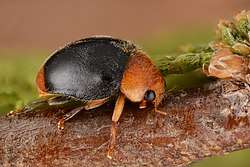Cryptolaemus montrouzieri
Cryptolaemus montrouzieri, common name mealybug ladybird[2] or mealybug destroyer, is a ladybird species.
| Cryptolaemus montrouzieri | |
|---|---|
| Cryptolaemus montrouzieri. Dorsal view | |
 | |
| Side view | |
| Scientific classification | |
| Kingdom: | |
| Phylum: | |
| Class: | |
| Order: | |
| Family: | |
| Genus: | |
| Species: | C. montrouzieri |
| Binomial name | |
| Cryptolaemus montrouzieri | |
Etymology
Étienne Mulsant described C. montrouzieri, naming the new species after a Marist brother and missionary, Abbe Montrouzier, who wrote an "Insect Fauna of Woodlark Island".[2]
Distribution
Cryptolaemus montrouzieri is endemic to Queensland and New South Wales, Australia. It is now also present in southern Europe (France, Italy, Spain, Greece), in North Africa, in the Afrotropical realm, in the Nearctic realm, and in the Neotropical realm.[3][4]
Description

Cryptolaemus montrouzieri can reach a length of about 6 millimetres (0.24 in). Adults of this species have the typical ladybird shape but, unlike many of the often brightly coloured Coccinellidae, the elytra of these small ladybirds are predominantly dark brown and have no spots. Head, antennae, pronotum, the end of the elytra and the legs are orange-brown.[5] Larvae can reach a length of 14–15 millimetres (0.55–0.59 in). They show a waxy covering that makes them apparently look like the mealybugs they prey on,[6] a case of aggressive mimicry.
Biology
The adults and larvae of these insects eat scale insects, especially mealybugs. Females lay their eggs among the egg sack of mealybugs. Larvae feed on mealybug eggs, young crawlers and their honeydew. They become adults in 24 days, after three larval stages and a pupal stage. The life span lasts two months.[7][8]
Biological control agent
This species has been used as a biological control agent against mealybugs and other scale insects.[2][5] It was introduced to Western Australia.[2] In California it was introduced in 1891 by Albert Koebele to control the citrus mealybug.[5] It has also been introduced to New Zealand for biocontrol.[6] As biological control agent outside Australia, C. montrouzieri has the common name Mealy bug destroyer.[5][7]
See also
- Hoangus venustus (a native New Zealand species which also feeds on mealybugs)
Bibliography
- A. Ślipiński, Australian Ladybird Beetles (Coleoptera: Coccinellidae) Their biology and classification - Australian Biological Resources, 2007, p94.
- Chako, M.K., P. Bhatt, L.V. Rao, A. Deepak Singh, M.B.E.P. Ramnarayana and K. Sreedharan, 1978. The use of the lady bird beetle (Cryptolaemus montrouzieri Mulsant) for the control of coffee mealybug. Journal of Coffee Research 8: 14–19
- Crowe, A. Which New Zealand Insect?. — Auckland, N.Z.: Penguin Books, 2002. — P. 47
- Gordon, Robert D. (1985) The Coccinellidae (Coleoptera) of America North of Mexico, Journal of the New York Entomological Society, vol. 93, no. 1
- Korschefsky, R. / Schenkling, S., ed. (1931) Coccinellidae I, Coleopterorum Catalogus, Pars 118
- Mineo, G., 1967. Cryptolaemus montrouzieri, Observations on morphology and bionomics. Bulletin of the Institute of Entomology and Agriculture 6: 99–143.
- Murthy, M.S., 1982. Studies on the biology and habits of Cryptolaemus montrouzieri Mulsant (Coccinellidae: Coleoptera). M.Sc. (Agriculture) Thesis, Andra Pradesh Agricultural University, Hyderabad, India.
- T. Ramesh BabuK. M. Azam - Biology of Cryptolaemus montrouzieri Mulsant [Coccinellidae: Coleoptera] in relation with temperature - Entomophaga (1987) 32: 381.
References
| Wikispecies has information related to Cryptolaemus montrouzieri |
| Wikimedia Commons has media related to Cryptolaemus montrouzieri. |
- "Cryptolaemus montrouzieri Mulsant, 1853". Integrated Taxonomic Information System. Retrieved 3 March 2012.
- "Cryptolaemus montrouzieri Mulsant". CSIRO. Retrieved 17 March 2009.
- Fauna europaea
- Catalogue of life
- Weeden, Shelton, Hoffmann (30 January 2008). "Cryptolaemus montrouzieri". Cornell University. Retrieved 18 March 2009.CS1 maint: uses authors parameter (link)
- Crowe, A. (2002). Which New Zealand Insect?. Auckland, N.Z.: Penguin. p. 47. ISBN 0-14-100636-6.
- "Know Your Friends - Mealybug Destroyer". www.entomology.wisc.edu University of Wisconsin. 14 February 2009. Archived from the original on 12 April 2012. Retrieved 18 March 2009.
- Mary Louise Flint, Steve H. Natural Enemies Handbook: The Illustrated Guide to Biological Pest Control
External links
- picture gallery at www.brisbaneinsects.com - includes images of C. montrouzieri larva preying on sap-sucking bugs
- Bug Guide
- Insects and Invertebrates